Both platforms give you the ability to build landing pages and sell your products, but they have some distinct differences that are likely to affect your decision-making process. In this Leadpages vs. SamCart comparison, we’ll go into the fine details of each platform to help you understand the difference between them.
Leadpages is all about landing pages, but it’s also capable of building full websites that are both eye-catching and functional.
SamCart is a little different and does away with the unnecessary extra time spent building and managing a full-on store. You can just go straight to selling your product, complete with tons of in-built analytics and marketing tools.
| A quick comparison: | ||
| Leadpages | SamCart | |
| Pricing |
|
|
| Page-builder and design |
|
|
| Payment processors |
|
|
| Marketing and analytics |
|
|
| Blogging |
| |
| Integrations |
|
|
| Customer support |
|
|
Table of Contents
What Is Leadpages and Who’s It For?
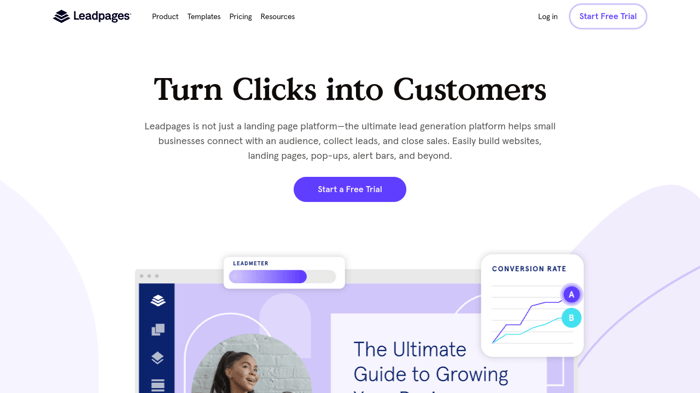
According to Leadpages, they are the ultimate lead generation platform. You can draw in customers, secure leads, and increase your sales – all with Leadpages. Build a website to host your e-commerce store, design high-converting landing pages for various purposes, and manage your customers.
Leadpages is popular with coaches, consultants, and just generally small businesses and freelancers. It’s easy to use, even for beginners, and the end results of the landing pages created are truly inspiring.
What Is SamCart and Who’s It For?
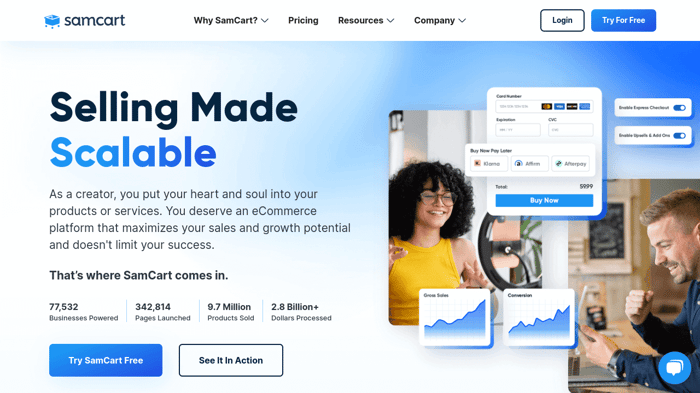
Simply put, SamCart is an online shopping cart, but it has some additional perks. Although you can’t build a full website with SamCart, that’s not its intention. SamCart is intended to help small businesses, creators, artists, or coaches bypass the need to build an entire site and just get on with selling their products.
It is also loaded with built-in marketing and analytics features while also allowing a wide range of billing models and payment processors. These built-in features and payment options are a big incentive to use the platform.
Pricing
Leadpages
There are two regular pricing plans: Standard and Pro. Both plans include free hosting and have access to many features like pop-ups, alert bars, and automated lead notifications.
All plan holders will receive unlimited traffic and be able to collect unlimited leads. Templates are mobile responsive, and there are over 40 integrations made possible with Leadpages.
To help you get started, there’s also a one-on-one quick start call with a Leadpages representative, and if you’re unsure, you can always try it for free for 14 days.
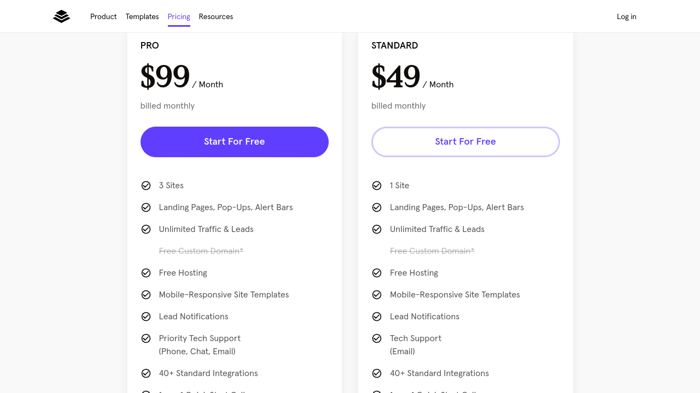
Standard Plan
The Leadpages Standard plan costs $49/month or $444/year (equivalent to $37/month). With this plan, you get all the features mentioned above and the following allowances:
- Ability to build one site
- Email and live chat customer support
Pro Plan
The Pro plan is $99/month or $888/year (equivalent to $74/month) and gives you a little bit more functionality than the Standard plan. Specifically, you’ll get the following:
- Three sites
- Priority customer support – phone, email, and live chat
- Ability to make sales and accept online payments
- Unlimited A/B split testing
Considering this plan gives you the ability to accept payments, it’s far more practical than the standard plan. With the ability to process payments, it means you can utilize your landing pages commercially.
A Little Extra: Advanced Plan
The Advanced plan is aimed more toward marketing freelancers who are managing several clients. In addition to what you get with the Pro plan, you’ll also get access to the following:
- A master account to manage up to five client accounts
- Advanced integrations
- One-on-one onboarding call
For prices, you’ll have to speak with the Leadpages team directly because this is a specialized plan.
SamCart
For SamCart, there are three regular pricing plans and a VIP plan. The three regular plans are Launch, Grow, and Scale.
All plans come with a range of core features, including unlimited products, pages, video uploads, and memberships. They also provide a quality library of templates. However, the real kicker is 0% payment processing fees.
SamCart offers a shorter free trial period than Leadpages – you have only seven days to decide if you want to continue using the platform via a paid plan.
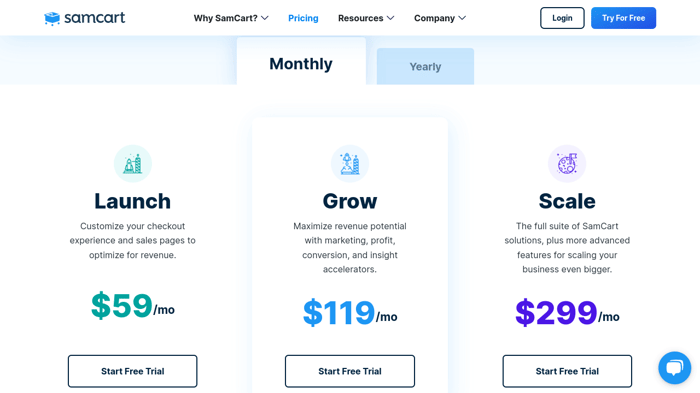
Launch Plan
The Launch plan starts at $59/month or $468/year (equivalent to $39/month). It includes what SamCart considers standard features – integrations, email support, and onboarding webinars. This plan gives access to one admin user only.
Grow Plan
The Grow plan costs $119/month or $948/year (equivalent to $79/month) and gives access to three admin users. In addition to the features included in the Launch plan, you’ll receive enhanced integrations, email support with a guaranteed one-day response time, and a one-on-one support call to get you set up and started.
Some additional features include:
- Order bumps
- Post-purchase upsells
- Built-in SEO tool
- Marketing reports
- Custom checkouts
Scale Plan
The Scale plan costs $299/month or $2,388/year (equivalent to $199/month), which is a significant price to pay. However, with this plan, you’ll get access for up to ten admins, all the features included in the Grow plan, plus:
- Custom CRM and API integrations
- Priority email support
- A dedicated SamCart expert (annual plan subscriptions only)
- Subscription saver tool
- Access to the Affiliate Center
- A/B split testing
- Automated reporting
VIP Plan
With the VIP plan, you’ll have access to all the features available in the Scale plan, as well as the ability to create multiple sub-accounts, which is perfect for agencies.
VIP plan holders get a dedicated SamCart account manager and assistance with technical setup and migration to SamCart. This plan is essentially customized to you, so you’ll have to contact the sales team directly for prices.
Features and Functionality Comparison
Page Builder and Design
How the page builder functions and the flexibility and freedom you have with design options are very important. Those without a technical background in web development often really appreciate the type of drag-and-drop builder that both of these platforms have. In that sense, they share a lot of similarities.
Leadpages
Leadpages gives you the ability to build both landing pages and an entire site with no limits on the number of pages you publish. It also gives you a selection of prebuilt templates specifically designed for both landing pages and full websites.
The drag-and-drop builder is easy to use, and you won’t need any coding skills. Alternatively, you can also choose to build from scratch without the use of a template, where you might need code.
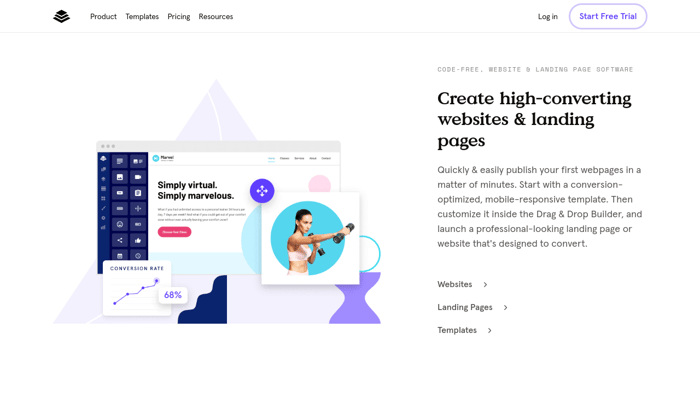
Everything you need to create attention-grabbing and high-converting landing pages is included. You can add opt-in forms, pop-ups, or alert bars to any page. In addition, all pages are mobile-responsive, so you don’t have to worry about getting penalized for not having a mobile-friendly site.
Overall, Leadpages does provide nicer-looking and more professional templates than SamCart, and the drag-and-drop builder is easier to use.
SamCart
SamCart also features a drag-and-drop page builder, as well as pre-designed templates, and will let you publish unlimited pages. The checkout pages are easy to edit and design how you want, and it’s no mystery why, as SamCart was originally an online shopping cart builder.
You can design the checkout pages exactly how you want and add the fields and forms you need. There’s a helpful Sandbox mode that allows you to test the checkout before it goes live.
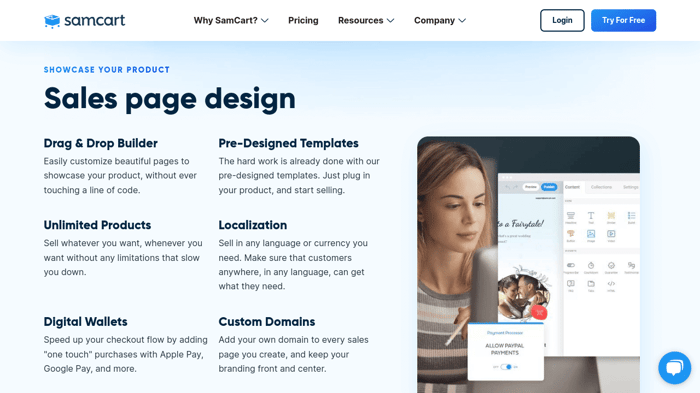
While the SamCart page builder is intuitive and easy to use, Leadpages is just that little bit better. Although, the ability to design your SamCart checkouts is a standout feature that often wins over prospective users.
Payment Processing and Customer Billing
With any e-commerce store, it’s crucial to understand which payment processors you can use, any additional fees charged, and the billing models you can make available to your customers. Typically, all payment processors will charge some fees, but neither Leadpages nor SamCart charges additional transaction fees on top of that.
Leadpages
With Leadpages, you can sell products from your website or landing pages with the built-in Leadpages checkouts. You can also accept recurring payments for service subscriptions or courses, but remember that you cannot accept payments at all with the lowest tier plan.
You do have far fewer payment processor options, though, as it’s only powered by Stripe. However, Stripe is a secure and very popular payment processor, so this may not be an issue. If you really wanted to, you could also integrate a different payment processor, like PayPal, but it’s not natively supported.
As you can see, Leadpages doesn’t offer anything outstanding in the way of payment processor options and variations in billing models for customers. SamCart definitely wins in this category.
SamCart
SamCart has quite a few advantages over Leadpages when it comes to payments. You are able to offer customers a wide range of billing options – from one-off payments, subscriptions, and trials to special payment plans of your choosing. There’s even a “Pay What You Want” offer, and you can also easily offer refunds or partial refunds.
In terms of payment processors available, there’s a range to choose from. SamCart can be connected with Stripe, PayPal, Braintree, EasyPayDirect, or Authorize.net. That said, Stripe or PayPal are the recommended payment processors as they are the most popular ones. There’s even a “Buy Now Pay Later” option using processors like Klarna or Afterpay.

If you subscribe to the Scale plan or above, you’ll have access to the Subscription saver, which is an automation that prompts the customer to continue with the payment if it is declined. If the customer doesn’t correct the payment details, then the subscription is canceled. This means that you won’t keep providing valuable course materials or services to a non-paying customer.
Marketing and Analytics Tools
In order to promote your products and make sales, you need to be marketing effectively and have a solid understanding of your customer base and their preferences. Whether these tools are built-in or can be integrated, they are essential to any e-commerce business.
Leadpages
Leadpages does rely heavily on integrations, but there are a ton of marketing integrations available, and that means you can connect the exact tool you want. You can also join their virtual workshops to help you develop a marketing strategy and get the most out of the tools you connect.
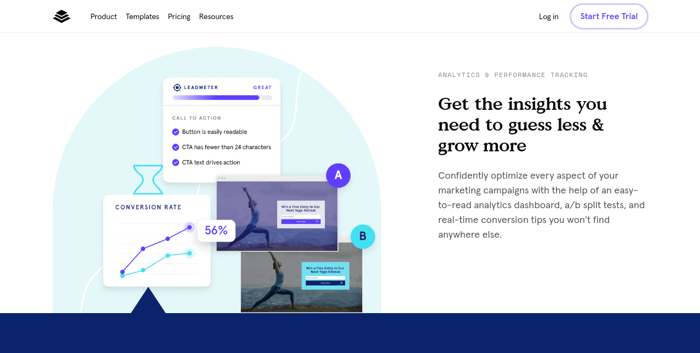
Leadpages does include built-in real-time analytics for all your pages, pop-ups, and forms. There’s also greater functionality with the Pro plan, as you get A/B split testing.
Leadpages also gives you access to marketing campaign reports. Overall, the built-in analytics tools are basic but functional. For anything more detailed, you can integrate a third-party analytics tool.
SamCart
SamCart provides a built-in sales and reporting dashboard. It includes what’s called “Smart Pixel Tracking,” which is an advanced customer behavior analysis designed to help you better understand how your customers are finding your products.
The Grow plan is actually where the majority of the features become available. It’s from this subscription plan that you can access one-click upsells, order bundling, different payment plans for customers, and white-labeling.
In addition, you get UTM tracking, which pinpoints the sources that your traffic is coming from. However, if you select the Scale plan, you’ll also get A/B split testing and custom reports.
Another benefit SamCart brings is an affiliate program. When you engage in an affiliate program, you let others act as your marketing team to bring in customers for a commission.
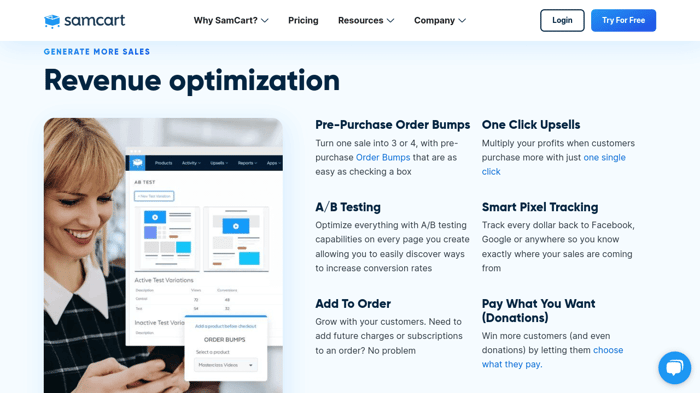
Overall SamCart takes the prize for marketing and analytics for a couple of reasons. One is that SamCart offers far more built-in features, whereas Leadpages relies heavily on integrations. The other reason is the affiliate center, which offers a lot of potential for anyone using SamCart and can really boost your sales efficiently.
Blogging Functionality
Neither platform technically has blogging functionality, but that doesn’t mean you’re completely left in the dark when it comes to blogging. You can still use the platform you want and produce an effective, professional blog.
Leadpages
In theory, it is possible to blog with Leadpages, except there isn’t a built-in blogging feature, so the workaround is pretty clunky. Leadpages suggests you create what is essentially a landing page to paste your blog posts into. If you only intend to produce a maximum of, say, ten blog posts, then using this method will be fine, but it’s far from ideal.
A better solution to add a blog to Leadpages is to integrate DropInBlog. By following a few short steps and copying the provided code, your blog will be activated on your Leadpages site. You can then develop and optimize your posts in the DropInBlog dashboard, and when you publish, they’ll appear immediately on your Leadpages site.
SamCart
The same can be said for SamCart – there’s no built-in blogging functionality, but integrating DropInBlog is super easy. To create a blog on SamCart, you’ll need to go through the same process as with Leadpages. Simply add the HTML block to the page you want your blog to appear on and paste the provided snippets of code.
Benefits of Using DropInBlog
When choosing a blogging platform, there are a number of reasons why DropInBlog can benefit your e-commerce venture.
For a start, just having a blog can improve your visibility in SERPs, increase organic traffic, and boost conversion rates. DropInBlog makes blogging easy, and its content editor is similar in style to WordPress, yet you won’t need any plugins or have security concerns.
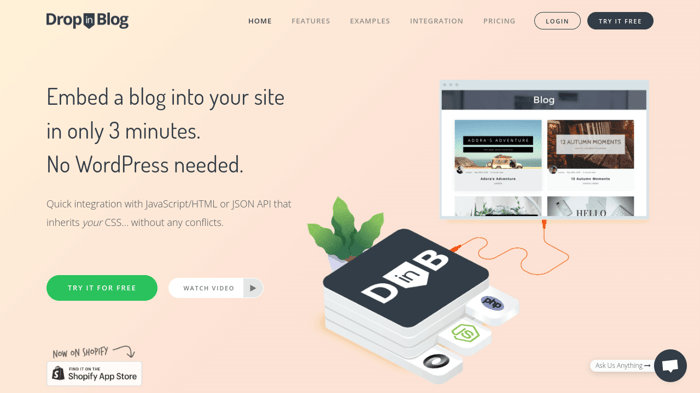
DropInBlog saves you time and hassle reformatting page designs every time you upload new content. It automatically adopts your page CSS and style and drops straight into place.
It also has a number of helpful blogging features like post scheduling, comment management, social sharing buttons, and the ability to add multiple authors. DropInBlog also has a really helpful SEO Analyzer tool to optimize your content.
Integrations
Integrations are what give a platform its flexibility and scalability. Even if there are a ton of built-in features, it’s still helpful if there’s a possibility to integrate alternative tools. This also means that you can upgrade to better apps with greater functionality as your business grows.
Leadpages
Leadpages offers a huge selection of integrations from a well-organized integrations page. Almost anything you could think of, you can connect – analytics, marketing automation, live chat, social media, payment processors, or scheduling tools. Some of the most popular integrations include:
Obviously, this means that Leadpages doesn’t offer as much built-in functionality. But to each their own – some people will prefer that they can integrate the specific tools they want.
SamCart
In contrast, SamCart doesn’t offer as many integration options, but with Zapier, the number increases. Much of what you can do with SamCart exists out of the box and comes included.
However, if you still want more and can’t find the integration you want, it’s possible to use other integration methods – like using HTML embedding to easily connect DropInBlog.
Customer Support
The need for customer support is a given – no matter how easy a platform is to use, there will come a time when you need assistance. Platforms with a poor track record of customer support or limited options to make contact or find solutions are a big red flag.
Leadpages
Leadpages provides email support only to Standard plan holders, but with the Pro plan, you’ll get phone, live chat, and email support.
With email inquiries, you can generally expect a response within 48 hours. There is also a Help Center, packed with documentation and guidance to assist you in finding solutions yourself. Moreover, you can access webinars and training courses or seek support through the Leadpages Facebook community.
It certainly seems as if Leadpages goes the extra mile regarding customer support, and reviews back that up.
SamCart
Customer support is not SamCart’s strong suit. There is essentially only email support with a response time that varies depending on your chosen plan. For example, those with the Scale plan get priority email support, and the Grow plan holders will get a response within a day.
Those on the Launch plan get no guarantees of a response time to their email inquiries. Alternatively, you can access live chat support for an add-on cost of $19/month.
While there are also webinars, courses, and documentation available online, SamCart’s customer support could be better overall.
FAQs
How does the checkout process differ for Leadpages and Samcart?
SamCart has made the checkout process smooth and simple, which boosts conversion rates. Leadpages checkouts are more on the clunky side in comparison. Leadpages doesn’t have a one-page checkout like SamCart, which means customers leave the page to enter the checkout.
How does the flexibility of templates compare between Leadpages and Samcart?
Leadpages takes the lead when it comes to templates. There are plenty to choose from, and they’re all mobile-responsive and professional-looking. You can also edit them without too much trouble.
SamCart, on the other hand, has fewer templates, and you can only make major changes if you subscribe to the Scale plan or higher.
Can I use DropInBlog on both Leadpages and SamCart?
Yes. Neither Leadpages nor SamCart have built-in blogging functionality. With DropInBlog, you can fill that gap and get professional-level blogging on both Leadpages and SamCart. It’s very easy to integrate and gives you all the features you need and then some.
Final Thoughts
In this Leadpages vs. SamCart comparison, we found out that while the two platforms are very similar in many ways – they are also quite different. For example, SamCart is better suited to those that want to get on with it and sell products more directly. On the other hand, Leadpages is better for building landing pages or a full e-commerce site, giving you the flexibility to choose which tools you need.
SamCart is slightly more expensive but includes far more features, whereas you’d have to use integrations to get the same functionality with Leadpages. Of course, by having a wide variety of integration options, Leadpages gives you more flexibility. Both platforms have a drag-and-drop builder and template libraries, but Leadpages gives greater design options and far nicer templates.
The main clincher comes down to payments and customer support. SamCart simply runs laps around Leadpages in terms of the payment models you can make use of and the variety of payment processors to choose from. However, SamCart is pretty lacking in customer support, while Leadpages provides a lot of assistance to their users.
All in all, they are both very good platforms that perform equally in some categories and very differently in others. Choosing between them will come down to where your priorities lie and what your business requirements are. Or perhaps you would like to know more about how SamCart stacks up against Shopify?




